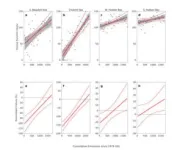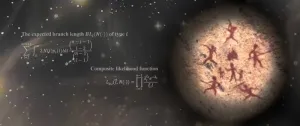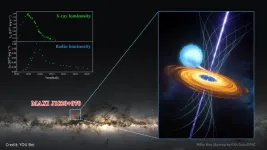(Press-News.org) PHILADELPHIA (August 31, 2023) – A main crux of neuroscience is learning how our senses translate light into sight, sound into hearing, food into taste, and texture into touch. Smell is where these sensory relationships get more complex and perplexing.
To address this question, a research team co-led by the Monell Chemical Senses Center and start-up Osmo, a Cambridge, Mass.-based company spun out of machine learning research done at Google Research, Google DeepMind (formerly known as Google Brain), are investigating how airborne chemicals connect to odor perception in the brain. To this end they discovered that a machine-learning model has achieved human-level proficiency at describing, in words, how chemicals might smell. Their research appears in the September 1 issue of Science.
“The model addresses age-old gaps in the scientific understanding of the sense of smell,” said senior co-author Joel Mainland, PhD, Monell Center Member. This collaboration moves the world closer to digitizing odors to be recorded and reproduced. It also may identify new odors for the fragrance and flavor industry that could not only decrease dependence on naturally sourced endangered plants, but also identify new functional scents for such uses as mosquito repellent or malodor masking.
“How our brains and noses work together”
Humans have about 400 functional olfactory receptors. These are proteins at the end of olfactory nerves that connect with airborne molecules to transmit an electrical signal to the olfactory bulb. The number of olfactory receptors is much more than we use for color vision - four - or even taste – about 40.
“In olfaction research, however, the question of what physical properties make an airborne molecule smell the way it does to the brain has remained an enigma,” said Mainland. “But if a computer can discern the relationship between how molecules are shaped and how we ultimately perceive their odors, scientists could use that knowledge to advance the understanding of how our brains and noses work together.”
To address this, Osmo CEO Alex Wiltschko, PhD and his team created a model that learned how to match the prose descriptions of a molecule's odor with the odor’s molecular structure. The resulting map of these interactions is essentially groupings of similarly smelling odors, like floral sweet and candy sweet. “Computers have been able to digitize vision and hearing, but not smell - our deepest and oldest sense,” said Wiltschko. “This study proposes and validates a novel data-driven map of human olfaction, matching chemical structure to odor perception.”
What is the smell of garlic or of ozone?
The model was trained using an industry dataset that included the molecular structures and odor qualities of 5,000 known odorants. Data input is the shape of a molecule, and the output is a prediction of which odor words best describe its smell.
To ascertain the efficacy of the model, researchers at Monell conducted a blind validation procedure in which a panel of trained research participants described new molecules, and then compared their answers with the model’s description. The 15 panelists were each given 400 odorants as well as trained to use a set of 55 words - from mint to musty - to describe each molecule.
“Our confidence in this model can only be as good as our confidence in the data we used to test it,” said co-first author Emily Mayhew, PhD, who conducted this research while a Monell postdoctoral fellow. She is now an assistant professor at Michigan State University. Brian K. Lee, PhD, Google Research, Brain Team, Cambridge, Mass., is also a co-first author.
The Monell team supplied panelists with lab-designed odor reference kits to teach them how to recognize the smells and select the most appropriate words to describe their perception. To avoid pitfalls from past studies like panelist conflation of “musty,” like a wet basement, and “musky,” like a perfume, training sessions and lab-designed odor reference kits taught each panelist the odor quality associated with each descriptive term.
The panelists were asked to select which of the 55 descriptors applied and to rate the extent to which the term best applied to the odor on a 1-to-5 scale for each of the 400 odors. For example, one panelist rated the smell of the previously uncharacterized odorant 2,3-dihydrobenzofuran-5-carboxaldehyde as very powdery (5) and somewhat sweet (3).
Quality control is also important in the final comparison of the human sniffers to the computer model. That’s where co-author Jane Parker, PhD, Professor of Flavour Chemistry, University of Reading, UK comes in. “I’ve worked on smell for many years, relying mainly on my own nose to describe aromas.”Her team verified the purity of samples used to test the model’s prediction. First, gas chromatography enabled them to separate out each compound in a sample, including any impurities. Next, Parker and her team smelled each separated compound to determine whether any impurity is overwhelming the target molecule’s known odor.
“We did find a few samples with significant impurities, among the 50 tested,” Parker said. In one case, the impurity was from traces of a reagent used in the synthesis of the target molecule and gave the sample a distinctive buttery smell that overpowered the odorant of interest. “In this case we were able to explain why the panel had described the smell differently to the AI prediction.”
Better Than a Human?
In comparing the model’s performance to that of individual panelists, the model achieved better predictions of the average of the group’s odor ratings than any single panelist in the study, impurities aside. Specifically, the model performed better than the average panelist for 53% of the molecules tested.
“The most surprising result, however, is that the model succeeded at olfactory tasks it was not trained to do,” said Mainland. “The eye-opener was that we never trained it to learn odor strength, but it could nonetheless make accurate predictions.”
The model was able to identify dozens of pairs of structurally dissimilar molecules that had counter-intuitively similar smells, and characterize a wide variety of odor properties, such as odor strength, for 500,000 potential scent molecules. “We hope this map will be useful to researchers in chemistry, olfactory neuroscience, and psychophysics as a new tool for investigating the nature of olfactory sensation,” said Mainland.
What’s next? The team surmises that the model map may be organized based on metabolism, which would be a fundamental shift in how scientists think about odors. In other words, odors that are close to each other on the map, or perceptually similar, are also more likely to be metabolically related. Sensory scientists currently organize molecules the way a chemist would, for example, asking does it have an ester or an aromatic ring?
“Our brains don't organize odors in this way,” said Mainland. “Instead, this map suggests that our brains may organize odors according to the nutrients from which they derive.”
Special Notes to Reporters
More information, including a copy of the paper, can be found online in the Science press package at https://www.eurekalert.org/press/scipak/.
This research was funded in part by Google Research and National Institutes of Health grants F32 DC019030 and T32 DC000014.
###
The Monell Chemical Senses Center is an independent nonprofit basic research institute based in Philadelphia, Pennsylvania. Founded in 1968, Monell‘s mission is to improve health and well-being by advancing the scientific understanding of taste, smell, and related senses, where our discoveries lead to improving nutritional health, diagnosing and treating disease, addressing smell and taste loss, and digitizing chemosensory data.
END
A step closer to digitizing the sense of smell: Monell Center, Osmo model describes odors better than human panelists
2023-08-31
ELSE PRESS RELEASES FROM THIS DATE:
New odor map helps match perceptions of smells with their chemical structure
2023-08-31
Brian K. Lee and colleagues have developed a Principal Odor Map (POM) that models the connections between an odorant’s chemical structure with its perceptual property of smell. The map performed as well as some highly trained human “sniffers” in describing odor quality, and could be used for predicting odor intensity and perceptual similarity between odorants. The map moves researchers closer to being able to match molecular properties of odorants to their perceptual properties, a challenge that has proved difficult for olfactory science. (For other senses, neuroscientists have been able to map light wavelengths ...
Early ancestral bottleneck could’ve spelled the end for modern humans
2023-08-31
How a new method of inferring ancient population size revealed a severe bottleneck in the human population which almost wiped out the chance for humanity as we know it today.
An unexplained gap in the African/Eurasian fossil record may now be explained thanks to a team of researchers from China, Italy and the United States. Using a novel method called FitCoal (fast infinitesimal time coalescent process), the researchers were able to accurately determine demographic inferences by using modern-day human genomic sequences from 3,154 individuals. These findings indicate that early human ancestors went through a prolonged, severe bottleneck in which approximately 1,280 ...
Genomic model suggests population decline in human ancestors
2023-08-31
Between 800,000 and 900,000 years ago, the population of human ancestors crashed, according to a new genomic model by Wangjie Hu and colleagues. They suggest that there were only about 1280 breeding individuals during this transition between the early and middle Pleistocene, and that the population bottleneck lasted for about 117,000 years. The researchers say about 98.7% of the ancestral population was lost at the beginning of the bottleneck. This decline coincided with climate changes that turned glaciations into long-term events, a decrease ...
Student engagement improves calculus class outcomes among undergraduates
2023-08-31
A randomized trial involving 811 undergraduate students at a U.S. Hispanic-Serving Institution (HIS) university found that students assigned to calculus classes focused on collaborative learning and student engagement had a greater understanding of calculus concepts and improved grades compared to those assigned to classes taught in a traditional lecture style. Laird Kramer and colleagues note that the success of the engagement “treatment” occurred across all racial and ethnic groups, academic majors, and genders. Since ...
Pedigree approach estimates surprising genetic mutation rate in baleen whales
2023-08-31
A new estimate of the genetic mutation rate in four wild species of baleen whales suggests that these rates are higher than previous estimates, with some interesting implications for calculations of past whale abundance and low cancer rates. For instance, the new mutation rate determined by Marcos Suárez-Menéndez and colleagues reduces estimates of abundance in pre-exploitation whale populations by 86%, which has implications for population-rebuilding goals of whale conservation programs. The mutation rate—the probability ...
Early ancestral bottleneck could've spelled the end for modern humans
2023-08-31
This release has been removed per the request of the submitting PIO. END ...
Developing silicones that are friendlier toward health and the environment
2023-08-31
Polysiloxanes, the scientific name for silicones, possess exceptional properties, and are used in numerous fields ranging from cosmetics to aerospace. They are absolutely everywhere! However, they have a major flaw, as small, cyclic oligosolixanes—toxic for the environment and identified as an endocrine disruptor—form during their synthesis. To correct this drawback, a team of scientists1 led by a CNRS researcher recently developed a new process for synthesising silicones in a cleaner and more environmentally-friendly ...
Study connects greenhouse gas emissions to polar bear population declines, enabling greater protections under Endangered Species Act
2023-08-31
New research from the University of Washington and Polar Bears International in Bozeman, Montana, quantifies the relationship between greenhouse gas emissions and the survival of polar bear populations. The paper, published online Aug. 31 in Science, combines past research and new analysis to provide a quantitative link between greenhouse gas emissions and polar bear survival rates.
A warming Arctic is limiting polar bears’ access to sea ice, which the bears use as a hunting platform. In ice-free summer months the bears must fast. While in a worst-case scenario ...
Exciting the brain could be key to boosting maths learning, says new study
2023-08-31
Exciting a brain region using electrical noise stimulation can help improve mathematical learning in those who struggle with the subject, according to a new study from the Universities of Surrey and Oxford, Loughborough University, and Radboud University in The Netherlands.
During this unique study, researchers investigated the impact of neurostimulation on learning. Despite the growing interest in this non-invasive technique, little is known about the neurophysiological changes induced and the effect it has on learning.
Researchers found that electrical noise ...
How does “MAD” accretion form around a black hole?
2023-08-31
An international scientific team has revealed for the first time the magnetic field transport processes in the accretion flow of a black hole and the formation of a "MAD"—a magnetically arrested disk—in the vicinity of a black hole.
The researchers made the discovery while conducting multi-wavelength observational studies of an outburst event of the black hole X-ray binary MAXI J1820+070, using Insight-HXMT, China's first X-ray astronomical satellite, as well as multiple telescopes.
Key to their discovery was the observation that the radio emission from the black hole jet and the optical emission from the outer ...





